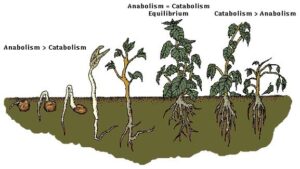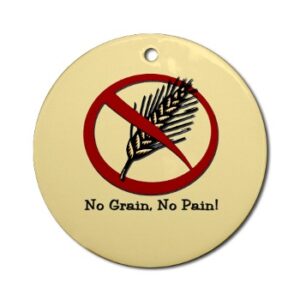Building Vibrant Health: Part 3
Today is the third part of a guest blog series from Eric Talmant. In case you missed them, check out Part 1 and Part 2.
Building Vibrant Health: Part 3
By: Eric Talmant
I am a human being. I am a white Caucasian. I am a male. I am an American citizen. I have blonde hair and blue/green eyes. I am 68 inches tall and weigh 175 pounds.
I am a protein-type. In my ANS, I am parasympathetic dominant. In my oxidative system, I am fast-oxidative dominant. My endocrine system is adrenal dominant. Overall, my dominance is fast oxidative. Therefore, my Metabolic Type® is fast oxidative. Broccoli is not a good food choice for me.

The Healthexcel System of Metabolic Typing® is based on a technology that William Wolcott collected and developed. Since 1987, health care professionals have used this technology to determine individualized nutritional requirements and diet plans. We have learned that various reactions take place daily and thus help to define the individual processes behind metabolism. Adaptation, metabolic efficiency, and (ideally) good health are made possible with energy by way of the Fundamental Homeostatic Control Mechanisms. Bill Wolcott’s Healthexcel System of Metabolic Typing® combines and uses all twelve Fundamental Homeostatic Control Mechanisms. They are the elements that define who we are metabolically.
We will first begin by discussing the three basic Metabolic Types®. Each type corresponds to a specific diet, but bear in mind that it is simply a starting point. We will discuss the fine-tuning of this diet later on.
The protein type means one of two things: either the parasympathetic branch of the ANS is stronger and more dominant than the sympathetic branch, or your cells burn carbohydrates too quickly meaning that you are a fast oxidizer. When the parasympathetic branch dominates, it causes the metabolism to be too alkaline. A high protein intake will acidify the already too alkaline metabolism, strengthening the sympathetic branch, and bringing it closer to balance with the already dominant parasympathetic side. If your oxidative system dominates, the protein will slow down the high oxidation rate (fast oxidizer) and will alkalinize your too acidic metabolism. In my case, I am parasympathetic dominant within my ANS, and I am a fast oxidizer within my oxidative system. HOWEVER, my oxidative system is the one that drives my metabolism. THEREFORE, I need plenty of protein to slow down my fast oxidation and alkalinize my too acidic metabolism. We will discuss taking the Metabolic Typing® Test later.
Protein types obviously do well on a diet high in protein but specifically those proteins that are high-fat proteins. These are known as “high purine” proteins and include foods like dark meat, chicken and turkey, red meat (buffalo, elk), lamb, organ meats, and seafood such as anchovies, herring, mackerel, mussels, sardines, scallops, salmon, and tuna. It is important to note that the mercury content in seafood has now made it a less desirable choice. Always choose fresh fish over frozen and wild over farmed fish. If you eat fish more than a few times a week, it might be a good idea to run an Internet search on the latest information concerning mercury and fish. Another good idea would be to go HERE and use the mercury calculator.

Most protein types also do well on whole fat foods in the form of milk, cream, eggs, cheese, and cottage cheese. They are free to use raw, organic butter, ghee, coconut oil, olive oil, natural cold-pressed oils (flax oil), fish oil, and raw nuts and seeds. The best carbohydrate sources are greens and non-starchy vegetables such as asparagus, cauliflower, celery, mushrooms, cabbage, cucumber, Brussels sprouts, onions, peppers, and tomatoes. All carbohydrates are high starch, medium starch, or low or non- starch, and as such do turn to sugar in the body (remember the insulin stuff?). The higher the starch content, the bigger the potential problem is for the metabolism of fast oxidizers because they tend to burn carbs too quickly.

A good macronutrient ratio for the protein type would be 70/30 percent. The 70% should come from high purine proteins and allowable fats and the 30% comes from carbohydrates. A good place to start would be 40% protein, 30% fat, and 30% carbohydrates. I have to emphasize that this is just a recommendation for a starting point. My diet actually consists of closer to 30% protein, 50% fat, and 20% carbohydrates. Again, we will discuss the fine-tuning of this diet in a later article, but for now this (40% protein, 30% fat, 30% carbohydrate) is the starting point for a protein type.
If a protein type ignores the requirement for a high amount of protein and fat at each meal or snack, and in contrast opts to eat freely of carbohydrates, the following are likely:
-the body will compensate by breaking down muscle tissue for protein
-adrenal and thyroid glands will not function properly
-the parasympathetic branch of the ANS will be strengthened
-the body will produce excess insulin, directing the body to store fat instead of burning it for energy
-fat storage will increase due to the cells being unable to efficiently carry out oxidative processes
-all of the above will result in a drop in metabolic rate
The Carbohydrate Type: As a general rule, if you are a carbo type than you need a diet made up of relatively small amounts of protein and fats compared to carbohydrates. The tendency of carbo types to metabolize food slowly is the main reason why large amounts of proteins and fats (especially the high purine ones) are to be avoided. Higher amounts of carbohydrates are needed to speed up the naturally slow oxidation rate of the carbo type, which will balance your too alkaline metabolism by acidifying it. The other possibility is the higher amount of carbohydrates will help to strengthen the parasympathetic side of the ANS, which tends to be weaker than the sympathetic side in the carbo type, and will alkalinize your too acidic metabolism.
Carbo types usually do well on a relatively low protein, low fat diet. This will enable them to feel energized both mentally and physically and stay on an even plane emotionally. Too much protein and/or fat will either leave them feeling tired and sluggish, or hyper, wired, and irritable.
The carbo diet should include liberal amounts of carbohydrates in the form of whole grains, fruits, and vegetables. It is important to note that a low protein diet does not mean a no-protein diet. It is equally important to note that in a future article, I will be outlining the typical diets that the Russian Olympic weightlifters used in the late 70’s and 80’s. If you think that all of these guys were ingesting 1.5 grams or more protein per pound of bodyweight, or lean bodyweight, or whatever it is these days that the latest guru is recommending, then think again. I hardly believe that we can argue with the success that the Russians, Bulgarians, and eastern Europeans enjoyed in Olympic weightlifting during this time period. Actually, for most carbo types, it will be necessary to include protein in most meals. However, they need to focus on the leaner, lighter meats, and lighter seafood. Ostrich, very lean red meats, chicken and turkey breast, and lighter seafood such as catfish, cod, flounder, haddock, perch, and sole are good examples. Carbo types also do well with low fat dairy products. Just like the protein type, however, the best carbohydrate sources for carbo types are vegetables with low or moderate levels of sugar and starch. Since the carbo type’s system converts carbohydrates into energy slowly, they can handle starchy or sugary foods just fine, and certainly better than the other two types. As with anything though, just be careful not to overdo it.
A good macronutrient ratio for the carbo type to follow is sixty percent to forty percent, with the sixty coming from carbohydrates and the forty coming from proteins, oils, and fats. A good place to start would be twenty-five percent protein, fifteen- percent fat, and sixty- percent carbohydrates. A good example of a carbo meal would be a 3oz or so chicken breast with baked potato and steamed broccoli or a mixed-greens salad with olive oil and vinegar. Again, remember that this is just a general starting point for carbo types, and that we will discuss fine tuning your macronutrient ratio or personal fuel mix in a later article.
Unlike protein types, carbo types can sometimes eat carbohydrates by themselves without experiencing any “ill effects” such as weakness, lethargy, or an energy crash. If a carbo type goes against their recommendations and eats a large amount of protein and fats with inadequate amounts of carbohydrates, the following are likely to occur:
-fat storage will increase due to the cells being unable to efficiently carry out oxidative processes
due to a shortage of glucose from the carbohydrates, the body will tear down or catabolize its own muscle tissue in order to obtain the necessary fuel to function, DESPITE the fact that you are eating “adequate” amounts of proteins and fats
-adrenal and thyroid glands will not be able to function properly
-all the above will result in weight gain due to decreasing the metabolic rate

Finally, we have the Mixed Type. They fall somewhere between the protein types and the carbo types on the metabolic scale, if you will. It is a mixture of the two types, which have more clearly indicated metabolic imbalances. Now, within the mixed type are two subtypes. The first is referred to as the A-mixed type, or actual type. The actual type displays characteristics that are neither protein type nor carbohydrate type dominant. They tend to have “average” appetites, feeling hungry at traditional mealtimes. They are not hungry between meals much, if at all.
The second mixed subtype is the R-mixed type, or relative type. Instead of displaying traits that are in the middle like the A-type, the R-type exhibits strong traits from both sides. However, neither trait dominates the other. The protein type traits that are expressed are counterbalanced by the amount of carbohydrate type traits, offsetting each other. R-types fluctuate between sometimes having a ravenous appetite and other times not feeling hungry to the point that they could skip meals.
Because mixed types do well on the widest range of foods, they are the least likely among the types to have a problem with weight. They need to consume a good mixture of protein type foods and carbohydrate type foods. This means balancing both high and low purine proteins with both high and low starch carbohydrates including legumes, vegetables, fruits, and grains. The mixed type does best on the typical “balanced” meal. This will accomplish two things. First, it will support both the sympathetic and the parasympathetic sides of the ANS. Second, it will keep their cellular oxidation rate, which is neither too fast or to slow, in balance.

Typically, mixed types do not feel the need for snacks. In theory, any type of snack will work. However, we are looking for those snacks that work the best. Individual trial and error is the only way to tell for sure, but just remember to be cognizant and aware of how you feel after eating a particular snack. Good snacks will obviously satisfy their appetite, provide energy and a feeling of well being, and not leave them craving sweets. Dairy foods are optional for mixed types, simply because dairy works well for carbo types and not so well for protein types. The lower the starch content in a carbohydrate, usually the better it is for all types, mixed included. However, most mixed types will be able to get away with those carbohydrates that contain more starch and are higher on the glycemic index.
Those mixed types that have blood sugar problems should avoid wheat and wheat products as much as possible. Wheat breaks down into sugar faster than any other grain, resulting in excess insulin.

A good macronutrient ratio for the mixed type to follow would be 50/50%. Shoot for 50% of your calories from protein and fats and the remaining 50% from carbohydrates. It is recommended that mixed types start with the majority of the 50% coming from protein rather than fat. Essentially, we are looking at 30% coming from proteins, 20% coming from fats, and 50% coming from carbohydrates. This would be the recommended starting point for a mixed type. Like the other types, try to eat at regular intervals, and try to be consistent with meal times and snack times from day to day. Most importantly, try and get a good balance between protein type and carbohydrate type foods. It is not necessary that you equally divide food between the two groups and each and every snack and meal. However, at the end of the day, be sure that your overall food intake was close to equal and that all types of proteins and carbohydrates were eaten. A good example of a mixed type meal would be 4-8oz of lamb with roasted potatoes, broccoli, and a mixed green salad.
Now that we have identified the various Metabolic Types®, system dominance, and the proper starting point for macronutrient ratios of each type, we need to actually take the Advanced Metabolic Typing® test and start putting all of this knowledge to practical use. In the next article, I will discuss options for taking the test as well as the test itself. It consists of sixty-five questions that have no right or wrong answers and has been used for over twenty years yielding a high degree of accuracy.
Once you have taken the test and identified your Metabolic Type®, we will discuss the techniques and ways to fine-tune or customize your diet to your own highly individual needs. It is truly empowering to finally come to understand exactly what foods and food combinations will allow you to function and perform optimally in every aspect of your life.
About the Author
Eric Talmant is a top lightweight powerlifter and has a “passion for all things nutrition.” A 1996 graduate of the University of Evansville, Eric is a Certified Metabolic Typing® advisor and Functional Diagnostic nutritionist. Talmant is certified to offer the Advanced Metabolic Typing® Test as well as order blood work (the Signet MRT Test, U.S. BioTek ELISA IgG allergy test, the High Sensitivity C-Reactive Protein heart health test, and the BioHealth Diagnostics Adrenal and Hormone Profiles to name a few) and dispense hormones.
Eric has competed in the ADFPA, NASA, AAPF, APF, APA, the WPO, and the Raw Unity Meet. He holds the APF Florida state men’s open equipped squat record of 678 pounds. He has been ranked in the top in the 75K class among all raw lifters in the United States for the past two years and he was a top equipped lifter in the two years before that.
His best equipped lifts are a 683 pound squat, 391 pound bench press, and a 650 pound deadlift in the 75K weight class. His best raw lifts to date are 485 pound squat without knee wraps, 290 pound bench press, and 635 pound deadlift.
He is also the founder and contest director of the Raw Unity Meet, which experienced great success in 2008 and 2009.
Talmant brings a unique skill set and 16 years of nutritional experience to his sponsors BMF Sports, Ultra Life, Inc., Critical Bench, and Titan Support Systems. He lives in rural Spring Hill, Florida, and can be reached through his web site, EricTalmant.com.





